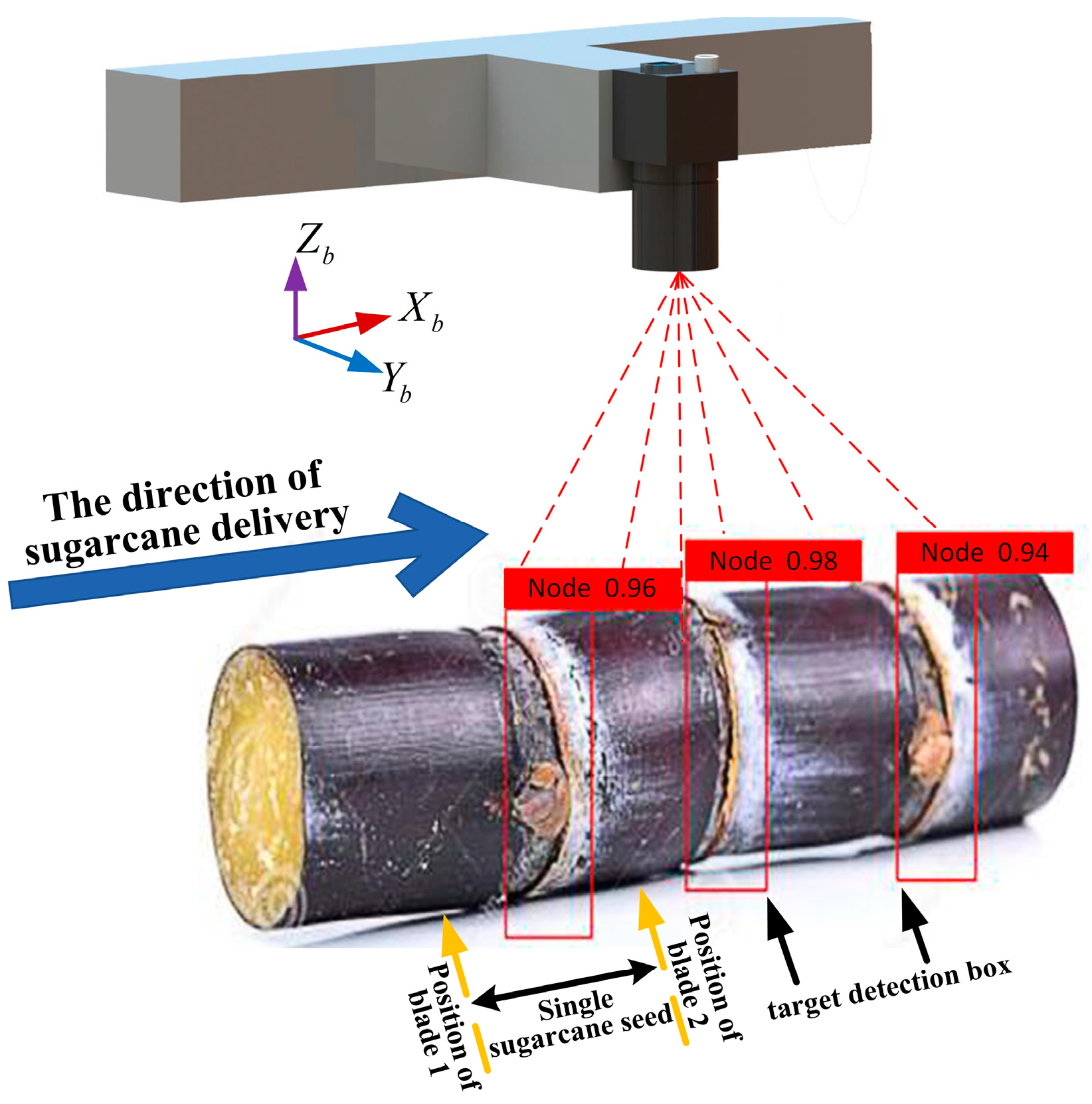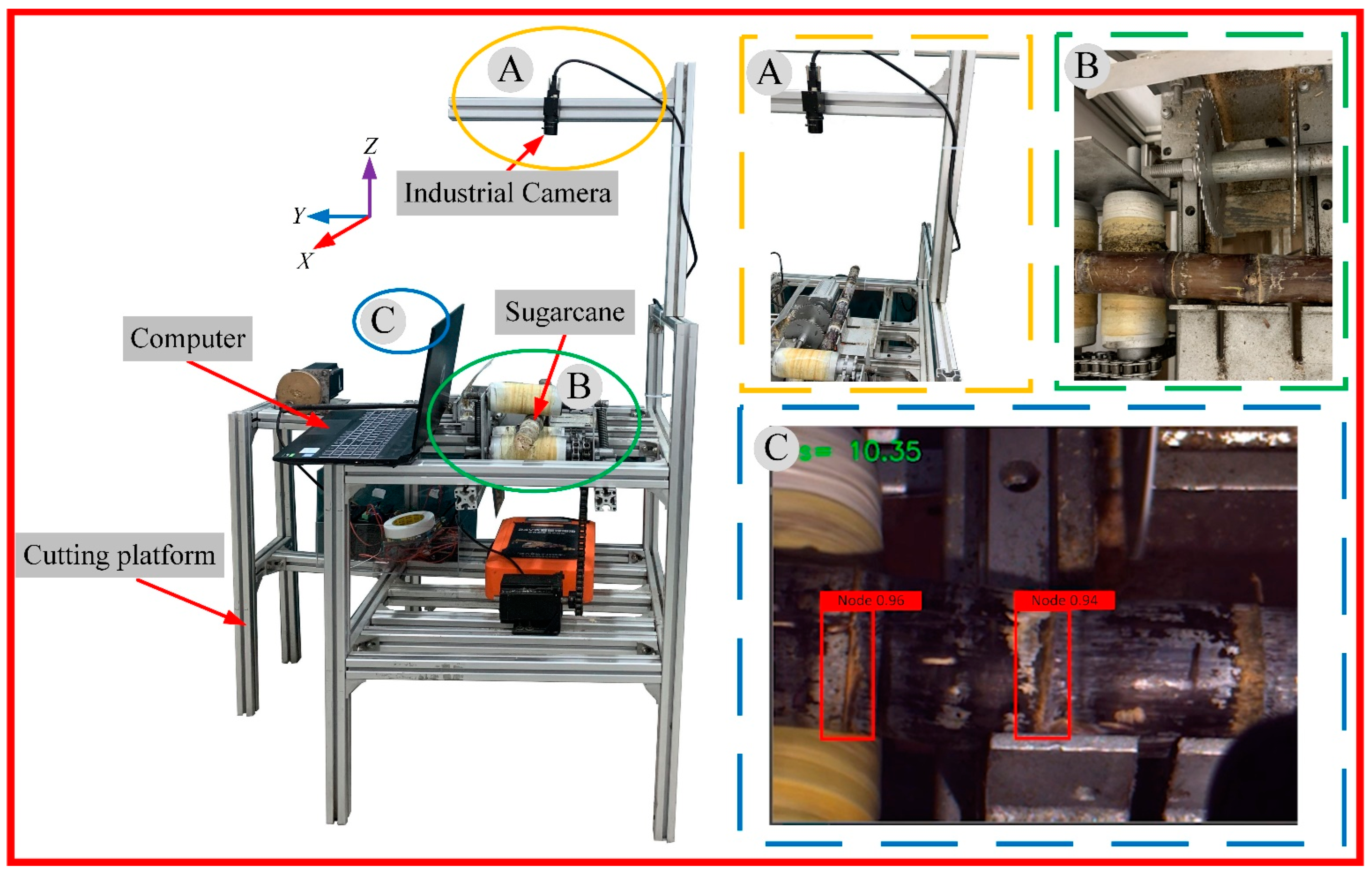Sugarcane-Seed-Cutting System Based on Machine Vision in Pre-Seed Mode
Abstract
1. Introduction
2. Materials and Methods
2.1. System Composition and Working Theory
2.1.1. Sugarcane-Cutting Device Platform
2.1.2. Sugarcane-Cutting System Composition
2.1.3. Operating Principle
2.2. Sugarcane-Cutting System Design
Seed-Cutting Device Design
- (1)
- The Core Structure Design of the Cutting Device
- (2)
- Rotary Cutting System Design
- (3)
- Communication System Design
2.3. Vision System Design
2.3.1. Dataset Establishment
2.3.2. Detect Network Training
2.3.3. Detection Information Extraction
2.3.4. Detect Network Comparisons
2.4. Control System Design
2.4.1. Hardware Selection
2.4.2. Control Policies
3. Results and Discussion
3.1. Test Materials and Equipment
3.2. Experimental Design
- (1)
- Carry out stepper motor wiring; Start the voltage regulation power supply; Adjust the DC motor speed in the high-speed rotary cutting mechanism; Open the industrial camera and the host computer.
- (2)
- Record the number of sugarcane eustipes in a group; After the motor in the working bench is stable, put a group of sugarcane into the shelf input guide in turn; Wait for all the sugarcane seed to be cut; Turn off the voltage regulation power supply, the host computer, and the industrial camera.
- (3)
- Record and calculate the eustipes recognition rate , the wound bud rate and the cutting rate .
- (4)
- Repeat the above steps until all 10 groups of sugarcane have completed cutting.
3.3. YOLOv5 Deep Learning Vision System
3.4. Cutting Bench Test Results
3.5. Discussion
4. Conclusions
Author Contributions
Funding
Institutional Review Board Statement
Informed Consent Statement
Data Availability Statement
Conflicts of Interest
References
- Nare, B.; Tewari, V.K.; Kumar Chandel, A.; Prakash Kumar, S.; Chethan, C.R. A mechatronically integrated autonomous seed material generation system for sugarcane: A crop of industrial significance. Ind. Crops Prod. 2019, 128, 1–12. [Google Scholar] [CrossRef]
- Mandal, S.K.; Maji, P.K. Design Refinement of 2 Row Tractor Mounted Sugarcane Cutter Planter. 2008. Available online: https://cigrjournal.org/index.php/ejounral/article/view/1014/1007 (accessed on 18 September 2022).
- Wang, Q.; Zhang, Q.; Zhang, Y.; Zhou, G.; Li, Z.; Chen, L. Lodged Sugarcane/Crop Dividers Interaction: Analysis of Robotic Sugarcane Harvester in Agriculture via a Rigid-Flexible Coupled Simulation Method. Actuators 2022, 11, 23. [Google Scholar] [CrossRef]
- Redmon, J.; Divvala, S.; Girshick, R.; Farhadi, A. You only look once: Unified, real-time object detection. In Proceedings of the IEEE Conference on Computer Vision and Pattern Recognition, Las Vegas, NV, USA, 27–30 June 2016; pp. 779–788. [Google Scholar]
- Zhou, D.; Fan, Y.; Deng, G.; He, F.; Wang, M. A new design of sugarcane seed cutting systems based on machine vision. Comput. Electron. Agric. 2020, 175, 105611. [Google Scholar] [CrossRef]
- Yunlei, F.; Deqiang, Z.; GanRan, D.; Fengguang, H.; Meili, W. Design and Research of Sugarcane Cutting Equipment Based on Machine Vision. J. Agricult. Mech. Res. 2021, 43, 55–60. [Google Scholar]
- Patil, A.; Dave, A.K.; Yadav, R.N.S. Evaluation of sugarcane cutter planter. Sugar Tech 2004, 6, 121–125. [Google Scholar] [CrossRef]
- Han, J.; Wen, S.; Liu, Q.; Wu, J.; Xu, J.; Wu, J.; Ou, C.; Yan, W. Design and test of pre-cutting type sugarcane planter. J. South China Agric. Univ. 2019, 40, 109–118. [Google Scholar] [CrossRef]
- Jadhav, P.; Jadhav, S.A.; Dunde, A.S. Proposed design of sugarcane node cutting by using machine vision technique. VJER-Vishwakarma J. Eng. Res. 2017, 1, 83–87. [Google Scholar]
- Kumar, M.; Dogra, B.; Sanghera, G.S.; Manes, G.S. Modification and Evaluation of Commercially Available Sugarcane Trench Planter for Its Application Under Punjab Conditions. Sugar Tech 2019, 21, 586–595. [Google Scholar] [CrossRef]
- Xue, M.; Chen, M.; Peng, D.; Guo, Y.; Chen, H. One Spatio-Temporal Sharpening Attention Mechanism for Light-Weight YOLO Models Based on Sharpening Spatial Attention. Sensors 2021, 21, 7949. [Google Scholar] [CrossRef]
- Chavan, P.; Tale, V.; Chavan, G. Automatic sugarcane node cutting machine. Int. J. Innov. Res. Sci. Eng. 2016, 12, 139–144. [Google Scholar]
- Wang, S.; Li, M. Mechanization of Sugarcane Planting Based on Computer Vision Identification Technology. NJYJ J. Agric. Mech. Res. 2017, 39, 198–201. [Google Scholar] [CrossRef]
- Huang, Y.; Wang, X.; Yin, K.; Huang, M. Design and experiments of buds-injury-prevention system based on induction-counting in sugarcane-seeds cutting. Trans. Chin. Soc. Agric. Eng. 2015, 31, 41–47. [Google Scholar] [CrossRef]
- Luo, Z.-Y.; Zhang, Y.-L.; Li, Y.-X. Simple Stepper Motor Control System. Mech. Electr. Eng. Technol. 2019, 48, 163–165. [Google Scholar] [CrossRef]
- Wu, W.; Yang, T.-l.; Li, R.; Chen, C.; Liu, T.; Zhou, K.; Sun, C.-m.; Li, C.-y.; Zhu, X.-k.; Guo, W.-s. Detection and enumeration of wheat grains based on a deep learning method under various scenarios and scales. J. Integr. Agric. 2020, 19, 1998–2008. [Google Scholar] [CrossRef]
- Li, X.; Ding, Q.; Sun, J.-Q. Remaining useful life estimation in prognostics using deep convolution neural networks. Reliab. Eng. Syst. Saf. 2018, 172, 1–11. [Google Scholar] [CrossRef]
- Li, J.; Hu, Q.; Ai, M. LAM: Locality affine-invariant feature matching. ISPRS J. Photogramm. Remote Sens. 2019, 154, 28–40. [Google Scholar] [CrossRef]
- He, X.; Cheng, R.; Zheng, Z.; Wang, Z. Small Object Detection in Traffic Scenes Based on YOLO-MXANet. Sensors 2021, 21, 7422. [Google Scholar] [CrossRef]
- Zhu, S.; Zhuo, J.; Huang, H.; Li, G. Wheat Grain Integrity Image Detection System Based on CNN. Trans. Chin. Soc. Agric. Mach. 2020, 51, 36–42. [Google Scholar] [CrossRef]
- Yang, C.; Liu, Y.; Wang, Y.; Xiong, L.; Xu, H.; Zhao, W. Research and Experiment on Recognition and Location System for Citrus Picking Robot in Natural Environment. Trans. Chin. Soc. Agric. Mach. 2019, 50, 14–22. [Google Scholar] [CrossRef]
- Xia, B.; Luo, H.; Shi, S. Improved Faster R-CNN Based Surface Defect Detection Algorithm for Plates. Comput. Intell. Neurosci. 2022, 2022, 3248722. [Google Scholar] [CrossRef]
- Li, H.; Li, C.; Li, G.; Chen, L. A real-time table grape detection method based on improved YOLOv4-tiny network in complex background. Biosyst. Eng. 2021, 212, 347–359. [Google Scholar] [CrossRef]
- Qi, X.; Dong, J.; Lan, Y.; Zhu, H. Method for Identifying Litchi Picking Position Based on YOLOv5 and PSPNet. Remote Sens. 2022, 14, 2004. [Google Scholar] [CrossRef]
- Zhou, H.; Xiao, J.; Kang, H.; Wang, X.; Au, W.; Chen, C. Learning-Based Slip Detection for Robotic Fruit Grasping and Manipulation under Leaf Interference. Sensors 2022, 22, 5483. [Google Scholar] [CrossRef] [PubMed]
- Parico, A.I.B.; Ahamed, T. Real Time Pear Fruit Detection and Counting Using YOLOv4 Models and Deep SORT. Sensors 2021, 21, 4803. [Google Scholar] [CrossRef]
- Yang, Z.; Ouyang, L.; Zhang, Z.; Duan, J.; Yu, J.; Wang, H. Visual navigation path extraction of orchard hard pavement based on scanning method and neural network. Comput. Electron. Agric. 2022, 197, 106964. [Google Scholar] [CrossRef]
- Zhang, C.; Yang, T.; Yang, J. Image Recognition of Wind Turbine Blade Defects Using Attention-Based MobileNetv1-YOLOv4 and Transfer Learning. Sensors 2022, 22, 6009. [Google Scholar] [CrossRef] [PubMed]
- Wu, D.; Lv, S.; Jiang, M.; Song, H. Using channel pruning-based YOLO v4 deep learning algorithm for the real-time and accurate detection of apple flowers in natural environments. Comput. Electron. Agric. 2020, 178, 105742. [Google Scholar] [CrossRef]
- Zhang, P.; Li, D. EPSA-YOLO-V5s: A novel method for detecting the survival rate of rapeseed in a plant factory based on multiple guarantee mechanisms. Comput. Electron. Agric. 2022, 193, 106714. [Google Scholar] [CrossRef]
- Xue, H.; Song, Z.; Wu, M.; Sun, N.; Wang, H. Intelligent Diagnosis Based on Double-Optimized Artificial Hydrocarbon Networks for Mechanical Faults of In-Wheel Motor. Sensors 2022, 22, 6316. [Google Scholar] [CrossRef] [PubMed]
- Buzzy, M.; Thesma, V.; Davoodi, M.; Mohammadpour Velni, J. Real-Time Plant Leaf Counting Using Deep Object Detection Networks. Sensors 2020, 20, 6896. [Google Scholar] [CrossRef]


















| Data Type | Normal Type of Sugarcane | Damaged Sugarcane | Sugarcane with Mud |
|---|---|---|---|
| Training set | 10,147 | 1552 | 1800 |
| Test set | 1128 | 173 | 200 |
| Total | 11,275 | 1725 | 2000 |
| Number of Groups | Actual Number of Eustipes/pcs | Number of Eustipes Cut/pcs | Rate of Eustipes Recognition/% | Number of Buds Injured/pcs | Rate of Buds Injured/% |
|---|---|---|---|---|---|
| 1 | 79 | 78 | 98.7 | 2 | 2.5 |
| 2 | 83 | 83 | 100.0 | 2 | 2.4 |
| 3 | 78 | 76 | 97.4 | 3 | 3.8 |
| 4 | 81 | 80 | 98.8 | 1 | 1.2 |
| 5 | 85 | 85 | 100.0 | 2 | 2.3 |
| 6 | 85 | 83 | 94.3 | 3 | 3.5 |
| 7 | 88 | 86 | 97.7 | 1 | 1.1 |
| 8 | 77 | 75 | 97.4 | 2 | 2.6 |
| 9 | 85 | 84 | 98.8 | 3 | 3.5 |
| 10 | 89 | 88 | 98.9 | 1 | 1.1 |
| Number of Groups | Total Number of Eustipes/pcs | Number of Eustipes Cut/pcs | Number of Eustipes Cut/pcs | Cutting Time/s |
|---|---|---|---|---|
| 1 | 18 | 18 | 12.6 | 0.700 |
| 2 | 17 | 17 | 12.2 | 0.718 |
| 3 | 20 | 19 | 13.9 | 0.732 |
| 4 | 18 | 18 | 13.1 | 0.728 |
| 5 | 19 | 19 | 13.7 | 0.721 |
| 6 | 19 | 18 | 12.9 | 0.717 |
| 7 | 17 | 17 | 12.4 | 0.729 |
| 8 | 21 | 20 | 14.3 | 0.715 |
| 9 | 20 | 20 | 14.6 | 0.730 |
| 10 | 23 | 21 | 15.6 | 0.743 |
Publisher’s Note: MDPI stays neutral with regard to jurisdictional claims in published maps and institutional affiliations. |
© 2022 by the authors. Licensee MDPI, Basel, Switzerland. This article is an open access article distributed under the terms and conditions of the Creative Commons Attribution (CC BY) license (https://creativecommons.org/licenses/by/4.0/).
Share and Cite
Wang, D.; Su, R.; Xiong, Y.; Wang, Y.; Wang, W. Sugarcane-Seed-Cutting System Based on Machine Vision in Pre-Seed Mode. Sensors 2022, 22, 8430. https://doi.org/10.3390/s22218430
Wang D, Su R, Xiong Y, Wang Y, Wang W. Sugarcane-Seed-Cutting System Based on Machine Vision in Pre-Seed Mode. Sensors. 2022; 22(21):8430. https://doi.org/10.3390/s22218430
Chicago/Turabian StyleWang, Da, Rui Su, Yanjie Xiong, Yuwei Wang, and Weiwei Wang. 2022. "Sugarcane-Seed-Cutting System Based on Machine Vision in Pre-Seed Mode" Sensors 22, no. 21: 8430. https://doi.org/10.3390/s22218430
APA StyleWang, D., Su, R., Xiong, Y., Wang, Y., & Wang, W. (2022). Sugarcane-Seed-Cutting System Based on Machine Vision in Pre-Seed Mode. Sensors, 22(21), 8430. https://doi.org/10.3390/s22218430







